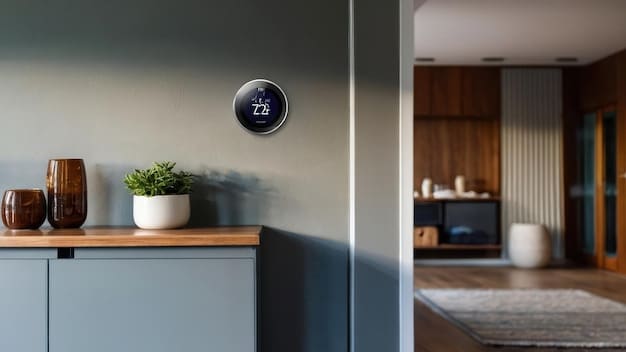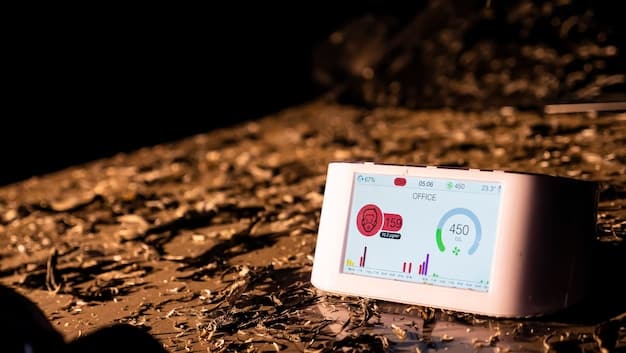Carbon Monoxide Poisoning: Smart Detectors to Save Your Family in 2025

Carbon monoxide poisoning is a silent killer, but smart detectors offer advanced features like real-time monitoring, smartphone alerts, and integration with smart home systems to protect your family in 2025 and beyond.
Carbon Monoxide Poisoning: How Smart Detectors Can Save Your Family in 2025 is a critical concern for homeowners. As technology advances, smart detectors offer enhanced safety features to combat this silent threat, giving you much needed peace of mind.
Understanding the Silent Threat of Carbon Monoxide Poisoning
Carbon monoxide (CO) is an invisible, odorless, and deadly gas produced by incomplete combustion of fuels. Knowing the dangers of CO and how it impacts your health is crucial for protecting our loved ones.
Carbon monoxide poisoning occurs when CO builds up in your bloodstream, replacing oxygen and preventing your organs and tissues from functioning correctly. Even low levels of CO exposure can cause health problems, while high levels can lead to death within minutes.
Sources of Carbon Monoxide in Your Home
Several household appliances and systems can produce CO if not properly maintained or ventilated.
- Furnaces and Heaters: Malfunctioning or poorly maintained heating systems are a primary source of CO leaks.
- Fireplaces: Wood-burning fireplaces can release CO if the chimney is blocked or not properly ventilated.
- Gas Stoves and Ovens: While designed for cooking, gas appliances can emit CO, especially if they are old or not properly adjusted.
- Generators: Portable generators used during power outages can produce deadly levels of CO, especially when used indoors or in enclosed spaces.

Symptoms and Risk Factors of CO Poisoning
The symptoms of carbon monoxide poisoning can be subtle and often mistaken for the flu. Recognizing these signs and understanding who is at risk can save lives.
- Common Symptoms: Headache, dizziness, weakness, nausea, vomiting, chest pain, and confusion are all common signs of CO poisoning.
- Vulnerable Groups: Infants, pregnant women, elderly individuals, and people with chronic heart or respiratory conditions are more susceptible to CO poisoning.
- Importance of Vigilance: Because CO is odorless and invisible, it’s essential to be vigilant and proactive in protecting your home and family.
Being aware of the sources, symptoms, and risk factors associated with carbon monoxide poisoning is the first step in ensuring the safety of your home and family. As we move forward, we’ll explore how smart detectors provide an advanced layer of protection against this silent threat.
The Evolution of Carbon Monoxide Detection Technology
Carbon monoxide detectors have come a long way, from basic alarms to sophisticated smart devices. In this section, we will look at the evolution of the Carbon Monoxide Detection Technology, along with basic CO detectors and how the technology improved.
Traditional CO detectors have been a staple in homes for decades, providing a basic warning system. However, traditional detectors have limitations such as their basic alarm functionality and lack of connectivity.
Limitations of Traditional CO Detectors
Traditional CO detectors primarily rely on a single alarm to alert residents. This basic functionality lacks the nuances and advanced features of modern smart detectors.
- Limited Information: Traditional detectors only sound an alarm without providing specific CO level readings or historical data.
- Lack of Connectivity: These detectors operate independently and cannot communicate with other smart devices or send remote alerts.
- Manual Testing: Regular manual testing is required to ensure the detectors are functioning correctly, which can be easily overlooked.
The Rise of Smart CO Detectors
Smart CO detectors represent a significant leap forward in home safety technology. They combine advanced sensing capabilities with connectivity and intelligent features.
- Real-Time Monitoring: Smart detectors provide continuous monitoring of CO levels, displaying real-time readings on a digital interface and sending immediate alerts when levels become dangerous.
- Smartphone Integration: These detectors connect to your smartphone via Wi-Fi, allowing you to receive notifications, view historical data, and manage detector settings remotely.
- Smart Home Compatibility: Many smart CO detectors integrate with other smart home systems, enhancing overall home safety and automation.

Key Features to Look for in Smart Detectors
When selecting a smart CO detector, consider key features that enhance functionality and reliability.
- Electrochemical Sensors: These sensors provide accurate and reliable detection of CO levels, ensuring timely alerts.
- Long-lasting Batteries: Look for detectors with long-lasting batteries or backup power options to ensure continuous operation during power outages.
- Voice Alerts: Clear voice alerts provide additional notification and guidance during CO emergencies.
As technology continues to advance, smart CO detectors offer a superior level of protection compared to traditional detectors. Their advanced features, connectivity, and real-time monitoring capabilities make them an essential component of modern home safety.
Advanced Features of Smart CO Detectors for 2025
As we look ahead to 2025, smart CO detectors are set to offer even more advanced features that enhance their effectiveness and user experience. Here are some of the key technological advancements we can expect.
Smart CO detectors come with advanced features. They go beyond just sounding an alarm and are able to do more things that help keep the family safe. These smart detectors are here to improve our home safety.
Enhanced Sensing Technology
Advancements in sensing technology will enable smart CO detectors to be more accurate and responsive.
- Improved Accuracy: Next-generation sensors will offer more precise CO level readings, reducing the chance of false alarms and ensuring timely alerts when needed.
- Multi-Gas Detection: Future detectors may incorporate sensors capable of detecting other dangerous gases, such as methane and propane, providing comprehensive air quality monitoring.
- Environmental Adaptation: Detectors will be equipped with algorithms that adapt to environmental conditions, minimizing interference from humidity and temperature changes.
Seamless Smart Home Integration
The ability to integrate seamlessly with other smart home devices and systems will be a defining feature of smart CO detectors in 2025.
- Automated Responses: Integration with smart thermostats and ventilation systems will allow detectors to automatically shut off gas appliances and increase ventilation when CO is detected.
- Emergency Services Connectivity: Future detectors may be able to automatically contact emergency services, providing critical information such as the home’s location and CO levels.
- Voice Assistant Compatibility: Seamless integration with voice assistants like Amazon Alexa and Google Assistant will allow users to monitor CO levels and receive alerts through voice commands.
Predictive Analytics and AI
The integration of predictive analytics and artificial intelligence (AI) will enable smart CO detectors to anticipate and prevent CO poisoning incidents.
- Pattern Recognition: AI algorithms will analyze historical data to identify patterns and predict potential CO leaks before they occur.
- Maintenance Alerts: Detectors will provide proactive maintenance alerts, reminding homeowners to schedule inspections and repairs for appliances that could produce CO.
- Personalized Recommendations: Based on individual home characteristics and usage patterns, detectors will offer personalized recommendations for improving home safety and preventing CO exposure.
In 2025, smart CO detectors will leverage advanced technologies to provide more accurate, responsive, and intelligent protection against carbon monoxide poisoning. These enhancements will make homes safer.
Choosing the Right Smart CO Detector for Your Home
Selecting the right smart CO detector involves evaluating various factors to ensure it meets your specific needs and provides reliable protection. First, establish the kind of safety your home needs to guide your decision-making.
When choosing a smart CO detector, start by assessing your home’s unique features and potential CO sources. Different homes have different safety needs, so consider the size of your home, the number of fuel-burning appliances, and the presence of vulnerable individuals.
Factors to Consider Before Buying
Before making a purchase, consider various factors such as sensor technology, battery life, connectivity, and ease of use.
- Sensor Technology: Opt for detectors with electrochemical sensors, which offer the best accuracy and reliability in detecting CO levels.
- Battery Life: Choose detectors with long-lasting batteries or backup power options to ensure continuous operation during power outages.
- Connectivity: Ensure the detector is compatible with your smartphone and other smart home devices for seamless integration and remote monitoring.
- Ease of Use: Look for detectors with a user-friendly interface and clear instructions for installation, testing, and maintenance.
Top Smart CO Detector Brands in 2025
Several reputable brands offer high-quality smart CO detectors with advanced features and reliable performance.
- Nest Protect: Known for its sleek design and comprehensive features, including voice alerts, smartphone integration, and self-testing capabilities.
- First Alert Onelink: Offers a range of smart detectors with advanced sensing technology, smoke and CO detection, and smart home compatibility.
- Kidde Nighthawk: Provides reliable CO detection with digital display, peak level memory, and easy installation.
Installation and Placement Tips
Proper installation and placement are essential for ensuring the effectiveness of your smart CO detector.
- Placement Guidelines: Install detectors on each level of your home, including bedrooms and near potential CO sources such as furnaces and water heaters.
- Avoid Obstructions: Do not place detectors behind furniture, curtains, or other obstructions that could block airflow and impede detection.
- Regular Testing: Test your detectors regularly to ensure they are functioning correctly and replace batteries as needed.
By considering your home’s specific needs, evaluating key features, and following proper installation guidelines, you can choose a smart CO detector that provides reliable and comprehensive protection for your family.
Integrating Smart CO Detectors into Your Smart Home Ecosystem
Integrating your smart CO detector into a broader smart home ecosystem can significantly enhance its effectiveness and provide a more comprehensive safety solution. It’s time to combine technologies for safety.
Connecting your smart CO detector with other smart devices and systems can create a more responsive and automated safety network. Explore the benefits of integrating your smart CO detector with other devices.
Benefits of a Connected Smart Home
A connected smart home offers numerous benefits, including enhanced safety, convenience, and energy efficiency.
- Enhanced Safety: Integration with other smart devices allows for automated responses to CO emergencies, such as turning off gas appliances and increasing ventilation.
- Remote Monitoring: You can monitor CO levels and receive alerts from anywhere with an internet connection, providing peace of mind when you’re away from home.
- Data Insights: Smart home systems can track CO levels over time, providing valuable insights into potential CO sources and helping you identify patterns that could indicate a problem.
Setting Up Smart Home Integration
Setting up smart home integration typically involves connecting your smart CO detector to a central smart home hub or platform.
- Choose a Compatible Platform: Ensure your smart CO detector is compatible with popular smart home platforms such as Amazon Alexa, Google Assistant, or Apple HomeKit.
- Follow Setup Instructions: Follow the manufacturer’s instructions to connect your detector to your smart home hub and configure desired settings and automations.
- Test Integration: Test the integration by simulating a CO event and verifying that alerts are sent to your smartphone and other connected devices.
Creating Automated Safety Scenarios
One of the key benefits of smart home integration is the ability to create automated safety scenarios that respond to CO emergencies.
- Automated Ventilation: Program your smart thermostat to automatically turn on the ventilation system when CO is detected, increasing airflow and reducing CO levels.
- Emergency Lighting: Connect your smart lighting system to your CO detector so that lights automatically turn on when CO is detected, helping occupants evacuate safely.
- Notifications to Emergency Contacts: Configure your smart home system to send notifications to emergency contacts when CO is detected, ensuring that help is on the way even if you’re unable to respond.
Integrating your smart CO detector into a smart home ecosystem creates a proactive safety network that enhances your home’s safety and provides greater peace of mind.
Maintaining and Testing Your Smart CO Detector
Regular maintenance and testing are essential for ensuring that your smart CO detector functions properly and provides reliable protection. Protect your family by ensuring your tools are working correctly.
Taking proactive steps to maintain and test your detector can help identify potential issues before they become critical. Let’s do what we can to protect our family.
Importance of Regular Testing
Testing your smart CO detector regularly ensures that its sensors and alarm system are functioning correctly.
- Manufacturer Recommendations: Follow the manufacturer’s recommendations for testing frequency. Most manufacturers recommend testing detectors at least once a month.
- Test Button: Use the test button on your detector to trigger the alarm and verify that it sounds properly.
- Smartphone App: Some smart detectors allow you to perform remote tests via a smartphone app, providing added convenience.
Battery Replacement Guidelines
Replacing batteries promptly is crucial for maintaining continuous operation of your smart CO detector, especially during power outages.
- Low Battery Alerts: Pay attention to low battery alerts and replace batteries as soon as possible.
- Battery Type: Use the recommended battery type specified by the manufacturer to ensure optimal performance.
- Backup Batteries: Keep spare batteries on hand so you can replace them immediately when needed.
| Key Point | Brief Description |
|---|---|
| 🚨 CO Risk | CO is an odorless, invisible, deadly gas. Detectors are key. |
| 📱 Smart Features | Real-time data, smartphone alerts, and smart home integration. |
| 🛠️ Maintenance | Regular testing and battery replacement are essential. |
| 🏡 Integration | Connect to smart homes for auto ventilation and emergency alerts. |
Proper Cleaning Techniques
Keeping your smart CO detector clean ensures accurate readings and prolongs its lifespan.
- Dust Removal: Use a soft brush or vacuum cleaner to remove dust and debris from the detector’s surface regularly.
- Avoid Chemicals: Do not use chemical cleaners or solvents, as they can damage the detector’s sensors.
- Ventilation: Ensure that the detector’s air vents are clear and unobstructed to allow proper airflow.
Frequently Asked Questions
▼
Carbon monoxide (CO) is an odorless, colorless gas produced by incomplete combustion. It’s dangerous because it displaces oxygen in the bloodstream, leading to oxygen deprivation and potentially death.
▼
Smart CO detectors offer real-time monitoring, smartphone alerts, and integration with smart home systems. Traditional detectors only sound an alarm when CO levels reach a certain threshold, lacking these advanced features.
▼
Install detectors on each level of your home, including bedrooms and near potential CO sources like furnaces and water heaters. Follow the manufacturer’s guidelines for optimal placement and coverage.
▼
Test your smart CO detector at least once a month using the test button. Some detectors also offer remote testing via a smartphone app. Regular testing ensures the detector is functioning correctly.
▼
If your smart CO detector sounds an alarm, immediately evacuate your home and call emergency services. Do not re-enter until the CO source has been identified and the air is safe.
Conclusion
Investing in a smart CO detector is a crucial step in protecting your family from the silent threat of carbon monoxide poisoning. As we move towards 2025, these devices will offer even more advanced features, ensuring a safer and more secure home environment.





